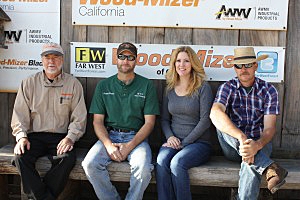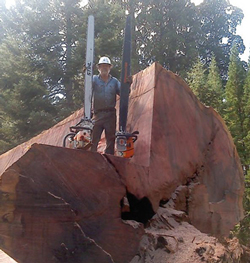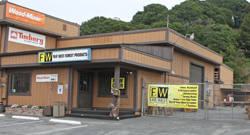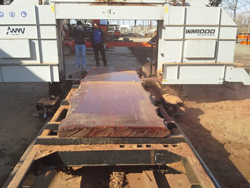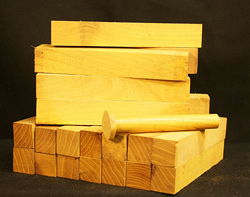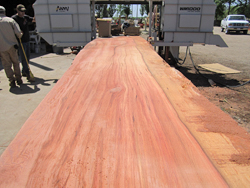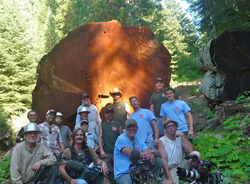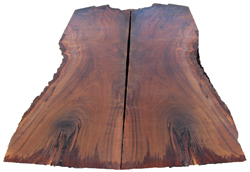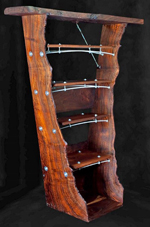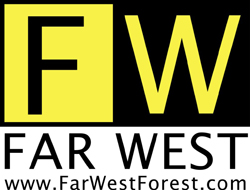
Imagine rolling out of bed in the morning with the prospects of wielding a nine-foot chainsaw before the day is through. Your goal: to turn three storm-downed, giant Sequoia redwood trees into usable lumber and save them from the prospects of slow decay on the forest floor. It’s all in a day’s work for the Evans family, who own and operate Far West Forest Products from their Sheridan, California, headquarters. They’re in the business of harvesting urban, salvaged and reclaimed trees and saving most of it from oblivion in California’s landfills.
“My father Jim, who founded our company, is a third generation licensed timber operator and has been in the business for more than 40 years,” says Jennifer Alger (Evans), Far West’s CEO. “He was a contract faller in the summer and a hardwood and burl buyer in the winter, working for the local hardwood mill.”
Her brothers Cody and Jason Evans have followed in dad’s footsteps. Both have grown up in the forestry business and have decades of licensed timber operator experience. Cody has logged more than a million board feet of custom lumber, using a Wood-Mizer® sawmill.He works on the construction and salvage logging aspects of the business, where much of the company’s salvaged, reclaimed and urban wood comes from. Jason is involved with Far West’s raw lumber, woods, milling and furniture-making, in addition to preparing lumber for a new Monterey Bay area store. Jennifer manages general operations, Wood-Mizer sales and helps develop commercial markets for lumber milled by small owner/operator sawmills.
Far West Forest Products is the only authorized sales and service center for Wood-Mizer in both California and Nevada.
“Back in the 1980s when the economy took a nosedive, my dad decided to start selling firewood under the Far West label,” Jennifer recalls. The company handled all aspects of firewood production: from logging, splitting and packaging to in-house marketing. Higher value logs were sold to local mills, while lower value material became firewood. It was a successful enterprise.
Then, when Wood-Mizer portable sawmills gained popularity in the 1990s, Far West bought its first portable mill, and that acquisition was a company game-changer. “We realized that we could mill better logs into lumber, and it would be far more valuable…so we added lumber to the firewood and logs we were already selling.”
Alger says turning salvaged (fallen trees still in log form) and reclaimed timber (wood formerly used in barns, bridges and other structures), as well as urban trees, into lumber wasn’t intended to be a form of trendy activism back then. It was a lucrative business decision. But, that initiative was also consistent with the family’s Christianity and sense of stewardship. “Wasting the resources God gave us … has never set right with us. Why allow what is already there to go to waste and cut down new material instead? My father is well-known for saying, ‘If God took the time to grow it, we’ll take the time to mill it.'”
Twenty or so years ago, it was estimated that in California alone, more than 3.8 billion tons of solid wood waste was sent to the landfill annually. That figure didn’t include logs that were ground up into wood chips or found their end as smoke up the fireplace chimney. Inevitably, trees are lost to unavoidable causes such as storm windfalls, disease and old age. Highway improvements and public safety concerns are other reasons why some trees eventually have to go. California’s fruit and nut agriculture also occasionally clear orchard trees in order to replant and increase productivity. Businesses like Far West buy these logs and turn them into often one-of-a-kind lumber, slabs and turning blanks. “We can better utilize the woods right here in our local communities,” Jennifer says. “In many cases, they’re every bit as beautiful as treasured exotics from around the world with burl, figure, spalting or other character features.”
California’s gentle climate also offers suitable growing conditions for species not found in many other states. Aside from the more common species such as ash, locust, cherry and various oaks, the Evans family is able to harvest Pacific madrone, palm wood, California claro walnut, mulberry, mango, pistachio and coastal redwood. Their selection of salvaged and urban lumber varies, based on what they are able to buy, cut and dry at any given time. “We take what we can get,” Jennifer says.
That “catch as catch can” mission produces more than 90 percent of Far West’s lumber, and the logs are sourced from within 500 miles of their Sheridan location. While some of it is sold to lumber mills or exported, the company also offers it to the public through its online store or at its Monterey retail location. Green, air-dried and kiln-dried lumber are in inventory. By the end of this year, the Evanses hope to add a kiln to their facility, too, instead of outsourcing the kiln-drying services elsewhere.
Acquiring and processing specific trees, as opposed to simply buying and selling truckloads of lumber from a mill, gives them a unique relationship with their lumber. “We know the story behind where almost every piece of our lumber comes from,” Jennifer said. That’s not a benefit about which most woodworking lumber suppliers can boast.
For instance, Jennifer recalls some mulberry trees Far West removed from the lot of a Walmart store in Yuba City. She says cutting the lumber produces bright yellow sawdust “that looks like a bumblebee exploded on you.” Or, there was the time when Far West reclaimed some 12 x 12 redwood timbers from the Yolo Causeway near Sacramento. They were coated with tar and probably destined to the landfill, but Far West cleaned them up and offered them for sale. It was the company’s first reclaiming job. Some of those timbers were also used to build the home where Jim and Diane Evans now live.
Or, once Far West saved some white oak logs “that we saw literally being fed into a chipper” during a levee improvement in Yuba County on the Bear River, just a few miles from Far West’s location. That salvage produced slabs and lumber with beautiful ray fleck and character, Jennifer recalls.
And of course, the Evanses will never forget the three giant Sequoia redwoods that came their way in 2011 and required that massive 9-ft. chainsaw and an enormous Wood-Mizer bandsaw machine to process them. The trees were estimated to be between 2,000 and 3,000 years old and were lost to natural causes on the side of a mountain. The first log they extracted was more than 16 ft. in diameter, with 18-in.-thick bark on one side. Jennifer says that even three years later, there are still two more 16- and 20-ft. logs yet to be milled from those trees. To date, Far West has turned the three windfall trees into 100,000 board feet of lumber, and counting. Jennifer has documented the event in exciting detail. You can read the full story, as originally published in the Spring/Summer 2013 “The Wood-Mizer Way” magazine, by clicking here.
Just last year, news of their experience with redwood salvage attracted the attention of Discovery Communications, who featured the Evanses on the pilot episode of the “Redwood Kings” reality series show on Animal Planet. Only time will tell what new adventures will come along as their reclaimed and salvage business continues to grow.
Jennifer says working in the family business is a labor of love, and their shared goals and principles are the key to what makes working so closely with family possible. Then, there’s the sweet reward that comes from taking back wood that otherwise might be lost forever, and sharing it with fellow woodworkers.
“It is nice to know we are able to give these trees a second life and repurpose them into something that will last for generations to come.”
